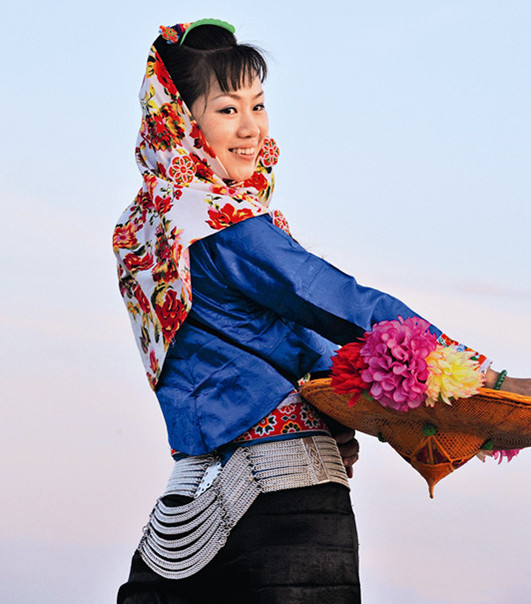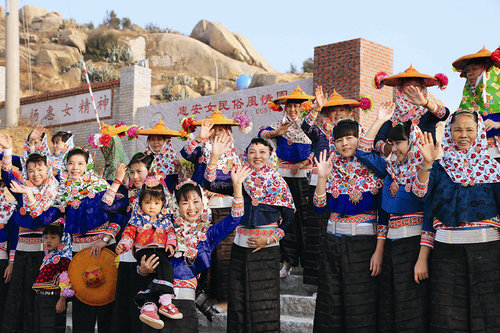 |
| Zeng Meixia, a Hui'an woman [Women of China English Monthly] |
Dazuo, a village in Hui'an County, in Southeast China's Fujian Province, is home to a special group of people — Hui'an women, who are known for their industriousness and unique clothing. Since 2008, Zeng Meixia, a Hui'an woman who lives in the village, has indulged her passion for advocating the spirit and traditional dresses of Hui'an women throughout the world.
Cultural Exchanges
During the winter of 2008, Zeng met several photographers, from other places, who visited Dazuo to shoot photos of Hui'an women. Zeng was interested in photography. She chatted with the photographers, and she showed them around the village. After she learned they didn't have a place to stay, Zeng invited them to stay at her home.
The photographers told Zeng they often saw several elderly Hui'an women wear the traditional dresses, but that they seldom saw young women in the traditional clothes. The photographers said they feared the younger generation of Hui'an women had abandoned the custom of wearing traditional Hui'an dresses.
Zeng was touched by their concern. "I really didn't want traditional costumes of Hui'an women to disappear … I hoped I could do my part to protect the traditional dresses of Hui'an women, and to encourage more people to wear traditional dresses," Zeng says.
The style of Hui'an women's clothing was shaped during the Tang Dynasty (618-907), and the style matured during the Song Dynasty (960-1279). In 2006, the style of clothing was added to China's list of national intangible cultural heritage. The traditional clothing of Hui'an women includes a yellow bamboo hat, a large kerchief, with flower patterns, a short jacket, a silver waist belt and loose pants.
In 2008, Zeng established Hui'an Women's Inn. It serves as a platform for cultural exchanges for photographers, painters, art-college students and tourists, from home and abroad, who visit Dazuo to create art and experience the culture and spirit of Hui'an women.
Zeng uploads photos of Hui'an women to her blog, microblog and website. As such, an increasing number of netizens have been able to learn about the inn, and many have chosen to stay at the inn.
"The inn has nine rooms, which can accommodate, at most, 40 visitors per day. The inn, decorated in a traditional way, reflects the local residential style. If there are more visitors, I have to arrange for them to live in other hotels. I hope more inns will open in our village," Zeng says.
To date, the inn has accommodated more than 50,000 visitors. "A foreigner lived at our inn for several months. He came here to learn to speak our local dialect, Hokkien. A couple from the United States came to vacation here, and they enjoyed collecting shells on the beach," Zeng recalls.
Zeng is impressed by David Paskett, one of the UK's leading watercolorists and President of the Royal Watercolor Society of UK. Paskett visited Dazuo in 2009. "He learned about me and my inn through my blog, and then he decided to visit our village to experience the local culture, and to paint local women," Zeng says.
"As he couldn't speak Chinese, and as I couldn't speak English, we had to communicate with each other through body language. I later downloaded translation software to help us understand each other. He spent three days here, and I was actually a tour guide for him. He told me that he enjoyed his time here," Zeng says.
Folklore
Although officially Han Chinese, the Hui'an women practice distinct customs and traditions that make them stand out from other Han Chinese and minority groups in China. Hui'an women are known for their hard work, bravery, kindness and wisdom. The women do most of the farm work and family chores while their husbands are at sea. From 1958 to 1960, the women built a reservoir, which was given the name Hui'an Women's Reservoir.
To help visitors better understand the history and lives of Hui'an women, Zeng established the Hui'an Women's Folklore Garden, near the seashore at the east end of Dazuo, in 2012. "Tourists, photographers and painters come to the garden to take photos and/or create paintings of Hui'an women, in traditional dresses, when they are fishing, mending nets, carrying stones, making embroideries and doing other family chores. The female visitors also like to try on the traditional dresses and experience the happiness of labor," Zeng says.
Zeng always consents when asked to model for painters or photographers. "At the beginning, elderly people, who were conservative, tended to think that posing as a model for painters and photographers was not elegant. I persuaded them that there was no problem for women to do so," Zeng says. Now, dozens of local women work as part-time models at the garden. Zeng's 5-year-old daughter and 85-year-old grandmother sometimes pose for visitors.
Since 2012, the garden has received more than 100,000 tourists, photographers, painters, calligraphers and art-college students.
Encouraged by Zeng's passion for traditional dresses, an increasing number of Hui'an women in Dazuo, and several neighboring villages, have begun wearing traditional dresses in their daily lives. They understand that visitors are attracted by Hui'an women's dresses, and the women feel proud when they wear such dresses. At night, the local women like to put on traditional dresses and dance in the squares. The dresses are especially favored by women born in either the 1980s or 1990s.
Inheriting Traditions
There is an 80-square-meter Hui'an Women's Museum in the garden, and that museum exhibits traditional Hui'an women's dresses and accessories, from throughout the ages, and antique furniture and various farm and fishing tools that Hui'an women use when they work.
"I began to collect traditional dresses, articles of daily use and labor tools from previous generations of Hui'an women when I established the inn in 2008 … According to local customs, when Hui'an women pass away, their personal belongings are burned. Nowadays, the number of traditional Hui'an women's dresses is decreasing," Zeng says.
"I hope that establishing such a museum will help preserve the heritage of Hui'an women, and help future generations better understand the traditional dresses and the spirit of Hui'an women. I have organized various activities for local kindergarten and primary and middle school students in the garden and the museum," she adds.
"Being industrious and kind are traditional virtues of Hui'an women. I think Hui'an women in modern times should also be independent, have the spirit of innovation and have the courage to challenge themselves … In the future, I plan to expand the museum to about 500 square meters, and to exhibit more items related to Hui'an women," Zeng says.
 |
|
Hui'an women [Women of China English Monthly]
|
By Wang ShashaEditor: Jian Tong and Amanda Wu(Source: Women of China English Monthly)
Using WeChat? Scan QR Code or Press the Fingerprint Below ↓
--- (Or ADD WeChat ID: OKOKOKOKnet)
